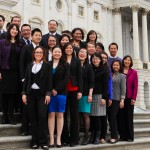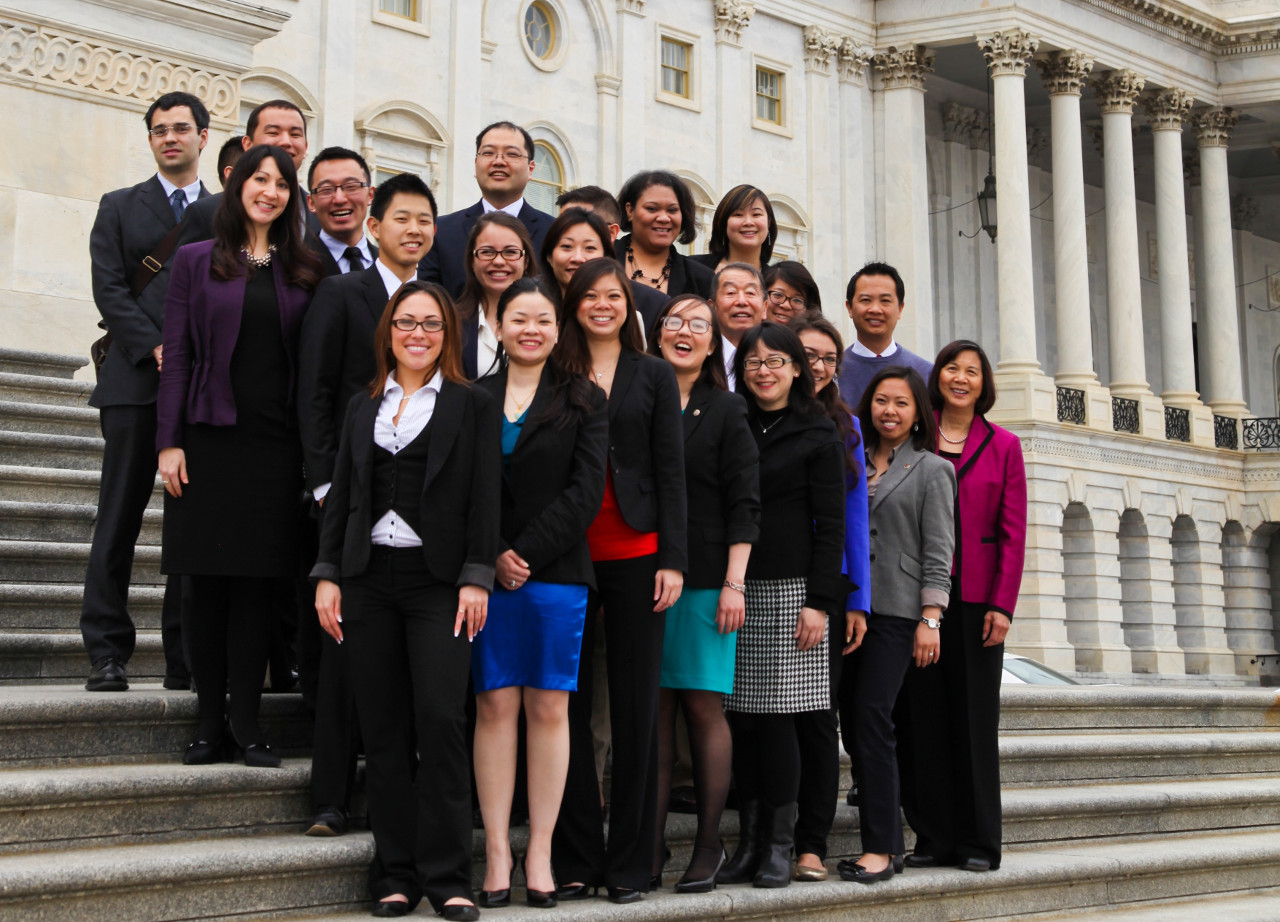My greatest fear in life is small talk. Laughing at the right times, maintaining proper eye contact, sipping a beverage, and staying aware of what is happening elsewhere in the room are just a few of the many activities I find nightmarish to juggle.
Thankfully, two hours of intense juggling at the Saturday evening welcome reception paid off, and I became acquainted with a few other summit participants, including Steve (a hapa from LA), Robert (a shin-nisei with a PhD from MIT), my roommate Leonard (a Chinese American from Honolulu). It was my honor to attend this year’s DC Leadership Summit, co-organized by JACL and OCA – Asian Pacific American Advocates and held March 8–11, 2014 in Washington DC.
Stuart Ishimaru, recently appointed head of the Office of Minority and Women Inclusion, spoke at the reception. He commented most memorably about how much DC has changed since he first came for law school many years ago. For example, the only place to get Asian food in DC those days was a tiny Chinese restaurant that greeted you with a bread basket and marinara sauce. Ishimaru reflected thoughtfully on his long career and the importance of increasing Asian American representation in politics.
Later that evening, I also had the pleasure of meeting two Hmong Americans from Minnesota, Kham and Liz. Coincidentally, Liz and I actually met last year. She was working in Senator Amy Klobuchar’s office when I visited with a group advocating for immigration reform during the JACL National Convention.
The next morning, we were up bright and early for breakfast at the National Education Association, where most of the workshops would be held over the next few of days. The first activity was led by Tom Hayashi, executive director of OCA, and proved to be the most astounding society simulation activity I have ever taken part in. Without going into too much detail, I would describe it as a carefully designed game that, despite everyone’s individual efforts, gradually separates participants into classes. For all but the highest class, winning becomes more or less impossible as the rounds progress, creating disappointment and even desperation in lower class participants.
The post-reflection activity focused on the futile aspects of class and mobility. I also took away some of my own points as well that I would add if I ever decided to facilitate a similar activity myself. In particular, many individuals were forced to make difficult decisions that pitted their own advancement against the advancement of others in their class. I would have liked to see a greater discussion about this phenomenon and its significance to civil rights movements, as I think being prepared to recognize and weigh individual and group interests is a critical skill of leaders.
That afternoon, Bree Romero from the Leadership Conference Education Fund and Terry Ao Minnis from Asian Americans Advancing Justice prepared us to advocate for immigration reform and the Voting Rights Amendment Act during our Tuesday visits to congresspeople. The Voting Rights Amendment Act (VRAA) is designed to replace the Voting Rights Act of 1965 that was struck down by the Supreme Court last year. The purpose of both acts is to require certain districts with a history of racial discrimination to clear any voting procedure changes with the federal government prior to implementation. It was struck down because the formula used to determine which districts were subjected to this preclearance requirement was considered deprecated.
One of the major dangers of failing to pass the VRAA is vote dilution. This happens when a district composed of blocks, in which one representative is elected per block, changes to an “at-large” district, in which the same number of representatives are elected by the entire district. This effectively allows 50 percent of the district to control all of the elected representatives. The problem comes in when some of the blocks tend to vote differently from the rest. For example, a predominantly Latino block in an otherwise white district can no longer elect a Latino representative because their vote has been diluted by transition to the at-large system.

Later that afternoon, we attended a social media training workshop led by Vincent Paolo Villano from the National Center for Transgender Equality. He is also co-founder of The Brain Trust, a digital strategy start-up. This was an exceptionally engaging and informative presentation from someone who is both an expert on social media campaigns and an outstanding presenter. Vincent’s talent lies in his ability to simplify the sometimes bewildering online world using common sense procedures and guidelines. His presentation was so inspiring, I have kept all of my notes in hopes of launching an online TCJACL campaign to reach younger audiences.
After this, we formed advocacy groups to plan out our conversations for Tuesday morning congressional visits. Our all-hapa group included Steve (from LA) and Emi (a shin-nisei from DC). We planned to use a recent case of a Los Angeles court that applied the VRA to challenge at-large voting policies of a district. Nearly half of the constituents in this particular district were Latino, but the at-large structure diluted their vote, resulting in just a single Latino council member being elected in the past 50 years.
Finally, it was time to relax at karaoke in Chinatown. I decided not to subject colleagues to the terror of my own singing, but really enjoyed listening to so many fantastic voices. In particular, Ken, a lawyer from San Francisco, and I connected over our 90s musical tastes. Nia, a Samoan American and charter school co-founder, left everyone speechless with her rendition of Whitney Houston’s “I Will Always Love You.”
The next morning, we attended a briefing by the White House Initiative on Asian Americans and Pacific Islanders (WHIAAPI). Speakers discussed immigration reform, the Affordable Care Act, and Asian American Native American Pacific Islander Serving Institutions (AANAPISI, “ann-ah-pea-see”). The last was of particular interest to me given my work in education. It is a new designation that allows institutions of higher education providing inclusive programming to access federal funds, not to mention one of the longest acronyms I have ever encountered. During the breakout session, I asked the AANAPISI speaker how institutions receiving federal monies were to be evaluated on their use of the grants. The program is just starting up, so he could not offer a clear answer. Given my familiarity with the politics of higher education at the University of Minnesota, these kinds of grants often fall into the hands of administrators unqualified to leverage the funds appropriately, so it will be interesting to see how WHIAAPI intends to ensure these federal monies result in effective interventions.
That afternoon, we attended a variety of workshops and panel discussions on advocacy and immigration reform. These discussions provided additional insights into the lives of immigration lawyers, policy advocates, and administrative aides.
Among these workshops was a presentation from State Farm, a major sponsor of the Leadership Summit and of JACL for many years. I never imagined I would be impressed by an insurance company, but they have a long history of admirable measures to improve the health of communities. Evannah Johnson, an eloquent speaker, shared information about several substantial grant programs targeting youth and non-profit organizations.
Before dinner, we visited the National Memorial to Japanese American Patriotism. I wrote about visiting this memorial during the National Convention last year in a previous issue of Rice paper. It combines historical elements of the Internment/Incarceration, 442nd Infantry Regiment, and Redress, and is centered around a beautiful sculpture depicting two cranes entangled in barbed wire. Unfortunately, I was disappointed in the docents, who seemed a bit unprepared for our visit. Having knowledgeable docents is important not only for the younger generations of Japanese Americans in attendance at the summit, but the diverse AAPI group from OCA, many of whom come with limited knowledge of the Internment.
That evening, we were honored by the presence of Chris Lu, deputy secretary of Labor. He is among the highest ranking AAPIs in the country and former classmate of President Obama at Harvard Law School. A surprisingly personable and engaging speaker, he stressed the significance of having chosen public service over private practice. He also spoke highly of the President as a classmate, reminiscing that even back then Obama commanded an awe-inspiring respect when he spoke up in class.
The next morning, Congresswoman Colleen Hanabusa and Congressman Mark Tanano spoke to our group at the Cannon House Office Building. Both were unsurprisingly excellent speakers. Takano’s told a particularly impactful story about visiting Seattle years ago to find the location of the property his issei grandparents purchased with their life savings (and then placed in the name of their nisei children because isseis could not own land). The internment began, and they subsequently lost the land because they were unable to make the required payments while incarcerated. After reviewing historical maps and other information, Takano was shocked to realize that the property was directly adjacent to the ritzy hotel he was staying at in downtown Seattle. His story left us in awe at the sheer quantity of wealth taken from his family as a result of the internment.
We then proceeded to get into our advocacy groups and visit our assigned congressperson. We were sent to meet with the legislative aide of Karen Bass (Los Angeles, D-37). I was not particularly happy with the way the meeting went. I was shocked when, instead of inviting us into an office (as did the two aides we met with during the National Convention), she pulled a chair right up to our couch in the waiting room. This not only resulted in her towering intimidatingly over us, but also in relaying the message that this was to be a quick and unimportant meeting. Steve did his best as a constituent to convey our message that passing the VRAA will require a bipartisan effort, but she did not seem to understand this and appeared to perceive our visit as more of an annoyance to her office than anything else. One explanation is that Bass seems recently to be putting more of her energy toward her role on the foreign affairs committee than her role on the judiciary committee (where the VRAA is currently being pushed).
After our Hill visits, we returned to the National Education Administration and wrapped up the summit. We were each asked to reflect briefly on our time in DC. I said that the summit really made me feel that JACL and OCA complemented each other in many ways and that I would like to see greater collaboration between the two organizations. There was not quite enough time elaboration, but I had two major reasons for thinking this.
The first reason concerns the membership body. JACL has a strong civil rights legacy due in part to the lasting impression of the internment, but is suffering organizationally from an aging and declining membership. While OCA is also suffering from membership aging and decline, it a relatively newer organization with a more inclusive Asian American focus. (For example, although OCA originally stood for Organization of Chinese Americans, it recently rebranded itself as OCA – Asian Pacific American Advocates.) Moreover, OCA membership is largely Chinese American, which is a growing demographic in the United States, thanks to an influx of Chinese students seeking education and employment in the US. This dynamic membership body is furthermore better supported by substantially larger portions of membership dues going directly to the individual chapters. This is in sharp contrast to the vast financial disparities created by JACL National membership policies.
On the other hand, I also believe there is a lot OCA can learn from the civil rights legacy of JACL. For example, I was disappointed by a recent press release from OCA National regarding California Senate Constitutional Amendment No. 5. OCA avoided taking a position on this amendment that would permit the reintroduction of affirmative action into California public schools and universities, and instead attacked the bill’s introducer, Senator Edward Hernandez, on the grounds that Asian American communities were not sufficiently consulted. Although JACL has unfortunately failed (as of March 22, 2014) to take a position on this particular issue as well, the National organization has in the past taken bold positions on controversial issues, sometimes to the disappointment of its own membership. For example, pursuing redress itself was a highly controversial decision. I feel the National leadership bodies of both organizations need to remain committed to taking bold, ethical stances on issues, even if such stances may warrant careful explanations to apprehensive membership bodies.
Being selected for the JACL/OCA DC Leadership Summit was truly an honor. Despite the frequent necessity of small talk, I found the summit a rich and valuable experience. I highly recommend it to others on account of the wonderful people who attend, exposure to the dynamic activities of social justice organizations in DC, and thought-provoking workshops. I would like to sincerely thank JACL and OCA for giving me this opportunity.

